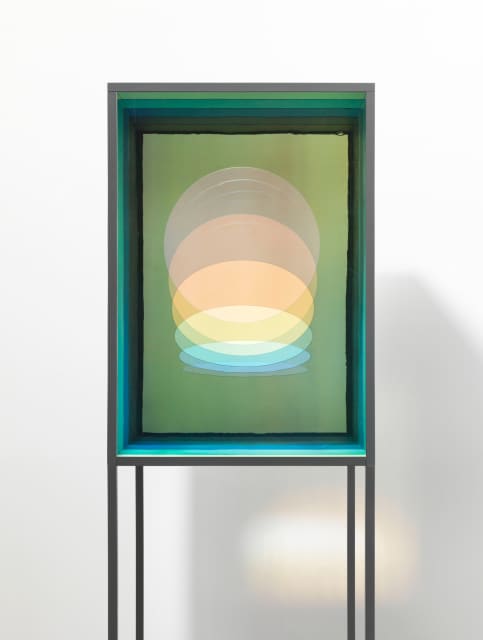
In 'Your trust', 2014, six panes of hand-blown, coloured glass have been arranged at eye-level inside an open metal box, one behind the other, to create an array of overlapping ellipses. Each pane has been tinted a single tone of green, blue, violet, red, orange, or yellow, and a different elliptical section, ranging from a thin oval to a full circle, has been cut out to create a dynamic progression of colour and geometry. The layering of the panes produces myriad tints that shift and emerge as the viewer moves about the work.
The elliptical cut-outs allow only highly restricted views of the sheets of glass within. Each pane is visible only through the filtering effect of the others, leaving the viewer uncertain about the actual colouration of the glass sheets (photo: Jens Ziehe).
‘Entering a museum is a way of stepping closer to society, to the realities that we live in. In a museum, you are able to see things in higher resolution. You become more focused, aware. Your senses become more alert; your body attuned; your mind open. What you encounter are most often artefacts or works of art. In my artistic practice I try to hand over the authority of deciding what is important in these encounters to the visitors. My artworks strive to embody transformation rather than stability and being.’ — Olafur's statement on ‘The curious desert’ at The National Museum of Qatar in 2023.
Video: ‘OLAFUR ELIASSON, الصحراء تعانق الخيال, THE CURIOUS DESERT, 2023’, Tigerlily Productions for Studio Olafur Eliasson and Qatar Museums. Directed by Lana Daher; Produced by Natasha Dack Ojumu.
‘Riverbed’ fills the white space of the museum with a grey, rocky landscape through which a narrow stream meanders. The landscape, comprising stones of various size and shape and in a range of grey tones, slopes up gently from where visitors enter and the stream disappears. Visitors are free to choose their own path as they move up towards the source of the stream, where the water bubbles up mysteriously through the stones. The contrast between these entirely new pathways and the routes suggested by the museum’s architecture challenges visitors’ expectations and invites them to find innovative ways of navigating the space.
Video: Documentation of ‘Riverbed’, 2014; previously installed LouisianaMuseum of Modern Art, Denmark, 2014.
Olafur Eliasson investigates how bodily and sensuous experiences lead to insights. Throughout his artistic production he has been concerned with how the physical world, nature’s fundamental elements, and basic phenomena such as light, darkness, and reflections can result in cognitive experience.
In the installation Your watercolour machine a floodlight projector directs its beams onto a prism, causing the light to be dispersed into separate colours which are then reflected in mirrors and the water surface of a pool and then, finally, projected onto a vertical screen, or canvas, where the field of colours meets us as a picture. A motor tilts the pool at regular intervals, disturbing the surface of the water, which in turn distorts the colours on the canvas, causing corresponding wavy movements.
In Eliasson’s work, the aesthetic experience arises as a response to a range of very concrete elements. The image on the classic, two-dimensional canvas arises out of basic physical phenomena, in the space occupied by the spectator. Eliasson’s installations create situations in which such new relationships between the work of art and the spectator can emerge.
It is well known that nonhuman species perceive the world very differently than we humans do – through different sensoria, different embodiments, different ecological priorities. This understanding offers the chance to playfully imagine ‘what it is like’ to perceive the world as a nonhuman.
This collection of films is an attempt to fictionally inhabit an imagined nonhuman perspective of Olafur’s exhibition ‘Life’, held at the Fondation Beyeler in Riehen, Switzerland, in 2021. The movement of the camera is inspired by the way an amphibian may inhabit the exhibition, or how a bee may circle spaces as they navigate them. While we can never claim to truly know – let alone experience – what it is like to exist in the world as an other, we can still test the limits of our imagination through experiments and form, and in so doing perhaps even grow our capacity for interspecies compassion.
Video: 'More-than-human views of Life’, 2021 (film: Aviatics GmbH; music: Patricia Bondesson Kavanaugh).
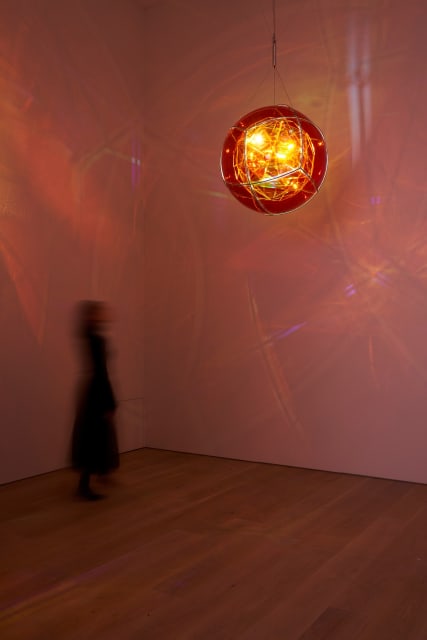
'Olafur Eliasson: A harmonious cycle of interconnected nows' explores the ideas central to Olafur’s new public artwork, 'A harmonious cycle of interconnected nows', 2023. From the large light-and-water installation 'Your split second house',2010 to 'Firefly biosphere (falling magma star)', 2023, a geometric sculpture containing intricately refracted light, to new drawings powered by sunlight, wind, and other phenomena of nature, 'A harmonious cycle of interconnected nows' presents a selection of works that appeal to the senses and are supported by research into natural phenomena, geometry, physics, movement and patterns.
Images: 'Firefly biosphere (falling magma star), 2023; currently showing as part of 'Olafur Eliasson: A harmonious cycle of interconnected nows' at Azabudai Hills Gallery, Tokyo; Opens to the public until 31 March 2024 (photo: Shimei Nakatogawa).
On view from today, 'Olafur Eliasson: A harmonious cycle of interconnected nows' opens to the public at Azabudai Hills Gallery, Tokyo, until 31 March 2024.
Part of the exhibition includes 'Your split second house', which uses strobe lights to illuminate the moving trajectories of water droplets as they fall through a dark space with a ceiling height of 5 meters and a length of over 20 meters, is the recreation of a work originally exhibited in 2010 for this exhibition. This abstract act of drawing with water and light elicits an understanding of the beauty inherent in Olafur’s long-standing interest in geometry.
Video: 'Your split second house', 2010; currently on view Azabudai Hills Gallery, as part of 'Olafur Eliasson: A harmonious cycle of interconnected nows'.
'Spherical space', 2015 contains two stainless steel frames, arranged one inside the other and connected at frequent, regular intervals, trace the geodesic lines of a latticework sphere. Affixed to the small connecting spans between the two frames are innumerable triangles of aluminium, hand-blown yellow glass, and colour-effect filter glass. A single bulb at the core of the sphere projects the dynamic pattern of shadows created by the triangles and framework onto the surrounding space.
Drawing inspiration from the mesmerising relationship between internal motion and external shape exhibited by schooling fish, the static surface of the work appears to be a flurry of movement. The geodesic lines of the sphere naturally draw the eye upwards in a whirlwind of tints and shapes, and even the slightest movement by the viewer alters the perceived alignment of spirals and triangles, creating the illusion of constant change. The viewer recognises her movements through the room in the motion she perceives in and on the sphere.
Video: 'How to turn a sphere'; The SOE team moves ‘Spherical space’, 2015, into position in the SOE studio.
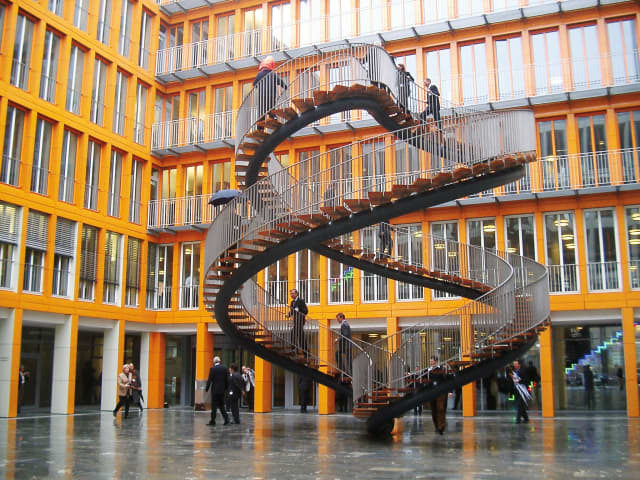
Permanently installed in the atrium of an office building in Munich, two spiral staircases interlock with each other, creating a continuous loop in the form of a double helix. To plan the work, a double helix was projected onto the surface of a sphere. The heights of the steps vary slightly to compensate for the curvature of the staircases, growing shallower at the poles. Precise engineering was necessary to enable the structure to balance on one point. The continuous loop of 'Umschreibung' contrasts starkly with the office courtyard in Munich, where it is installed. 'Umschreibung' – which can be translated as ‘circumscription’ or ‘periphrasis’ – proposes a movement without a destination, a space defined by motion rather than walls.
Images: 'Umschreibung', 2004; permanently installed at KPMG Deutsche Treuhand-Gesellschaft, Munich (photo: Thilo Frank).

A four-metre-tall column of disparate geometric forms, 'Power tower' was constructed as a stainless-steel framework, incorporating triangular panels of plywood and handblown, coloured glass in an intuitive, yet symmetric, manner. Light bulbs mounted at intervals along the length of the column illuminate it from within, casting variegated, angular shadows around the surrounding space. The geometric forms that make up the work were arrived at intuitively through playing with a children’s toy, known as Zometools, a construction set that consists of struts and nodes that allow great flexibility in creating geometric forms.
While the panels of plywood indicate the faces of the polyhedrons, the panes of coloured glass are embedded within the structure, sketching out a multicoloured core. The tones progress from purple at the floor through the major colours of the visible spectrum – red, orange, yellow, green, cyan, and blue at the apex.
Image: 'Power tower', 2005/2023; previously shown in 'The curious desert', in National Museum of Qatar, Doha, Qatar, 2023 (photo: Anders Sune Berg).
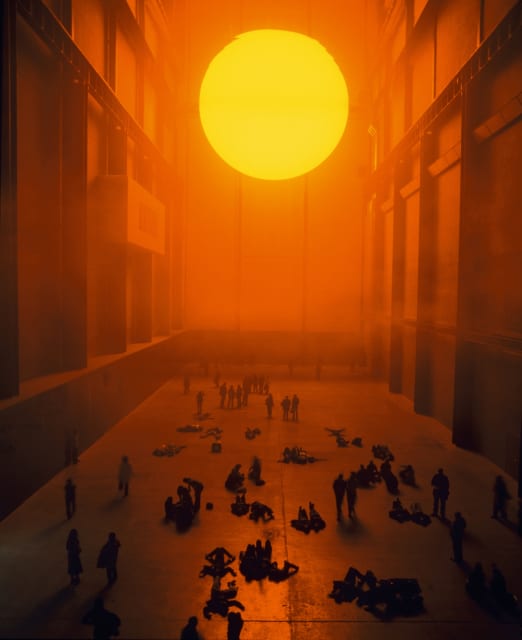
20 years ago, Olafur created 'The weather project' for the Turbine Hall of Tate Modern. This site-specific installation employed a semi-circular screen, a ceiling of mirrors, and artificial mist to create the illusion of a sun. Aluminium frames lined with mirror foil were suspended from the ceiling to create a giant mirror that visually doubled the volume of the hall – along with the semi-circular screen mounted on the far wall, its long edge abutting the mirror ceiling. Backlit by approximately 200 mono-frequency lights, the semi-circle and its reflection created the image of a massive, indoor sunset seen through the artificial mist emitted into the room. By walking to the far end of the hall, visitors could see how the sun was constructed, and the reverse of the mirror structure was visible from the top floor of the museum (photo: Tate Photography (Andrew Dunkley & Marcus Leith)).
A powerful HMI projector stands on the floor of a room in front of a wave effect machine. The wave effect machine is equipped with one yellow and one blue colour filter. The projector throws light onto a convex mirror, which reflects the coloured light across the entire space. The light is refracted, so that it resembles reflections on water. The light reflections move slowly up and down, affecting the viewers’ sense of balance.
Documentation of ‘Die organische und kristalline Beschreibung’, 1996; previously shown at Neue Galerie Graz, Austria in 1996.
'Riverbed', 2014, fills the white space of the museum with a grey, rocky landscape through which a narrow stream meanders. The landscape, comprising stones of various size and shape and in a range of grey tones, slopes up gently from where visitors enter, and the stream disappears. Visitors are free to choose their own path as they move up towards the source of the stream, where the water bubbles up mysteriously through the stones. The contrast between these entirely new pathways and the routes suggested by the museum’s architecture challenges visitors’ expectations and invites them to find innovative ways of navigating the space.
Behind the scenes with Olafur as he re-photographs the Icelandic glaciers that he first photographed twenty years ago, in 1999, for the making of 'The glacier melt series 1999/2019', 2019.
Documentation of 'Your collective decision', 2017
'The moving museum', 2009, shows two pairs of hands draw spaces against a black backdrop. Filmed with finger-tutting experts, 'The moving museum' constructs a flexible building that is in constant motion. Evoking the coordinates of three-dimensional space, the videos run simultaneously on three screens, two of which are positioned at a right angle to one another on a purpose-built table, while the third is embedded directly in the tabletop.
Sketching out ideas isn’t limited to pencil and paper. In 'Anti-gravity dance', Olafur Eliasson finds freedom from gravitational habits with the help of a large stone.
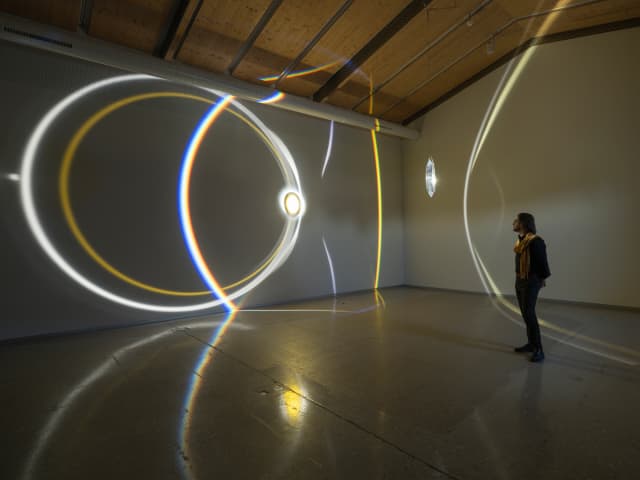
'To track the sun is to track yourself, because the sun tracker locates the centre of your orbital ellipse, giving your position right now and rendering visible your path. The reflexive potential lies in understanding that we are not the centre of the universe, but are in a way the mirrors, circulating, tracking, spinning in concert with others.' - Olafur Eliasson on 'Your circadian embrace', 2023; previously installed at 'Lighten Up! On Biology and Time' in EPFL Pavilions, Lausanne (photo: Julien Gremaud).

Olafur developed the visual concept for the contemporary ballet 'Tree of Codes', 2015, choreographed by Studio Wayne McGregor and with music composed by Jamie xx.
The stage design uses intricate sets of reflective, transparent, and refractive surfaces and coloured light to create a dynamic, ever-evolving, and complexly layered space in which the dancers are multiplied and overlap. Lights panning over the audience cause its spectral image to appear on the stage's reflective, coloured scrims, integrating the viewers with the activity on the stage. Triggered by Jonathan Safran Foer’s 'Tree of Codes' (an artwork in the form of a book, which was in turn inspired by Street of Crocodiles by Bruno Schulz), this new, evening-length work features a company of soloists from the Paris Opera Ballet and dancers from Wayne McGregor Random Dance (Photo: Joel Chester Fildes; Opera House, Manchester, 2015).
'Your hesitant kaleidorama' is the second kaleidorama in the exhibition ‘Olafur Eliasson: Orizzonti tremanti / Trembling horizons’, Castello di Rivoli' that focuses exclusively on the optical phenomenon of light flares in lens systems. The structure, attached to the wall along one mirrored side, is tilted downward toward viewers, who face the curved screen straight on. Reflected by the two abutting mirror panels, the optically enlarged mirrored space seems to expand down and away from the viewer in three dimensions. On the wall behind the screen, a wooden box with a slowly rotating arrangement of lenses and colour-effect filters refocuses a spotlight beam onto the rear of the screen. Coronas and tinted ellipses of light — usually considered as optical aberrations in photography or film — here instead become the focus in a complex, ever-changing display of shapes and shadows (video: SHIMURAbros / music: Olafur Eliasson and Petur Hallgrimsson).
Excerpt of @SHIMURABros' film ‘Rainbow assembly’, 2016, from Olafur’s solo exhibition ‘The parliament of possibilities’, 2016–17, at Leeum, Samsung Museum of Art, Seoul. Within a darkened space, multiple spotlights illuminate a circular curtain of fine mist. From certain perspectives, a shimmering rainbow can be seen in the falling water; it shifts in intensity or disappears as the viewer approaches or moves away.
'Your sound galaxy', 2012, suspends a group of twenty-seven polyhedrons from the ceiling in two horizontally concentric circles. Each polyhedron is made of a stainless steel frame clad in mirrored glass that has been turned inward so that the blue-grey backs of the mirrors act as the faces of the solid. A single halogen light mounted inside each polyhedron is multiplied by the reflective interior into a twinkling glow that escapes through the gaps in the frames. Previously shown at Red Brick Art Museum, Beijing 2018 (video: SHIMURAbros / music: afewnote).
It’s been five years since the completion of Fjordenhus, the first building designed by Olafur Eliasson and Sebastian Behmann for Kirk Kapital. Rising out of the water, Fjordenhus was created to forge a new connection between Vejle Fjord and the city centre of Vejle. The fjord flows directly through the building inviting in the elements – the wind, water, harbour, land, and the changing weather. The building brings together years of research in diverse fields into one project – urban space, light conditions, nature, physical movement, and how we use our senses. Fjordenhus melds artistic and architectural vision, incorporating site-specific artworks by Eliasson with specially designed furniture and lighting.

In 2005, Olafur’s exhibition 'The light setup’ at Lund Konsthall showcased various experiments employing ingenious technical solutions, turning the exhibition space into something reminiscent of a laboratory or artist's studio where visitors can not only study the techniques involved but even experiment themselves. Presenting the constructions as an important aspect of the works is a way of deliberately demystifying the phenomena that the visitor encounters and helps to break down their seemingly sensational aspects. Olafur thus invites visitors to be aware of their own vision and to take an active part in creating and experiencing the works. We become partners in creating the images that are generated.
Image: Installation view of 'The light setup’ at Lunds Konsthall, Sweden, in 2005 (photo: Terje Östling).
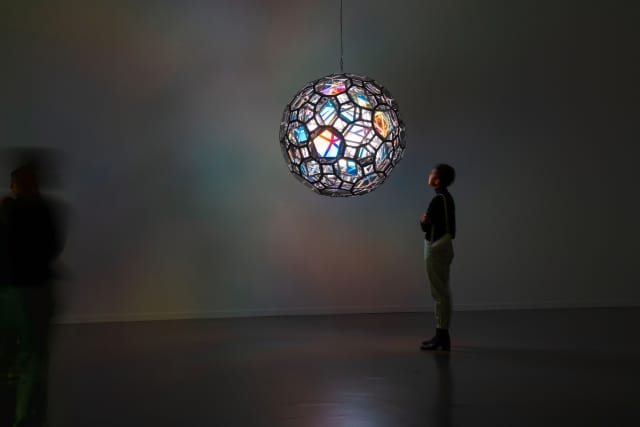
Four layers of progressively more complex polyhedrons form the framework structure of 'Weather orb'. The core is an icosahedron, a Platonic solid with twenty triangular faces, and the framework expands exponentially from one layer to the next, ending in the outermost layer composed of octagons, hexagons, squares, and decagons. Many of the polyhedrons’ faces are filled by either polarised filters or special plastic panes that interact to produce a range of tones. The combination of materials and the various angles and shapes of the faces create a complex interplay of light, colour, and shades of grey. Viewers’ movement around the work changes the alignment of the various panes, causing new colours and tones to emerge and vanish within the form.
Images: ‘Weather orb’, 2020; previously installed at Kunsthaus Zürich in 2020 (photo: Franca Candrian).